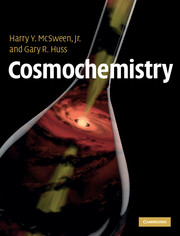Book contents
- Frontmatter
- Contents
- Preface
- 1 Introduction to cosmochemistry
- 2 Nuclides and elements: the building blocks of matter
- 3 Origin of the elements
- 4 Solar system and cosmic abundances: elements and isotopes
- 5 Presolar grains: a record of stellar nucleosynthesis and processes in interstellar space
- 6 Meteorites: a record of nebular and planetary processes
- 7 Cosmochemical and geochemical fractionations
- 8 Radioisotopes as chronometers
- 9 Chronology of the solar system from radioactive isotopes
- 10 The most volatile elements and compounds: organic matter, noble gases, and ices
- 11 Chemistry of anhydrous planetesimals
- 12 Chemistry of comets and other ice-bearing planetesimals
- 13 Geochemical exploration of planets: Moon and Mars as case studies
- 14 Cosmochemical models for the formation of the solar system
- Appendix: Some analytical techniques commonly used in cosmochemistry
- Index
- References
11 - Chemistry of anhydrous planetesimals
Published online by Cambridge University Press: 05 June 2012
- Frontmatter
- Contents
- Preface
- 1 Introduction to cosmochemistry
- 2 Nuclides and elements: the building blocks of matter
- 3 Origin of the elements
- 4 Solar system and cosmic abundances: elements and isotopes
- 5 Presolar grains: a record of stellar nucleosynthesis and processes in interstellar space
- 6 Meteorites: a record of nebular and planetary processes
- 7 Cosmochemical and geochemical fractionations
- 8 Radioisotopes as chronometers
- 9 Chronology of the solar system from radioactive isotopes
- 10 The most volatile elements and compounds: organic matter, noble gases, and ices
- 11 Chemistry of anhydrous planetesimals
- 12 Chemistry of comets and other ice-bearing planetesimals
- 13 Geochemical exploration of planets: Moon and Mars as case studies
- 14 Cosmochemical models for the formation of the solar system
- Appendix: Some analytical techniques commonly used in cosmochemistry
- Index
- References
Summary
Overview
Many asteroids are dry, as evidenced by meteorites in which water is virtually absent. These samples include many classes of chondrites, as well as melted chunks of the crusts, mantles, and cores of differentiated objects. Anhydrous bodies were important building blocks of the rocky terrestrial planets, and their chemical compositions reveal details of processes that occurred within our own planet on a larger scale. The distributions of these asteroids within the solar system also provide insights into their formation and evolution.
Dry asteroids and meteorites
Anhydrous planetesimals formed within the inner solar system, unlike the ice-bearing bodies discussed in the next chapter. These objects, composed of rock and metal, were the primary building blocks of the terrestrial planets. Relics of that population may survive today as asteroids that dominate the inner portions of the main belt.
Asteroids have been a focus of spectroscopic studies for decades. Spectra obtained from telescopes on the Earth can identify some of the minerals that make up asteroids, but do not measure asteroid chemistry. Nevertheless, spectroscopic matches can be used to link some meteorite classes to their probable parent bodies, and thus allow indirect assessments of their chemical compositions. A few asteroids have been visited and analyzed by spacecraft. Chemical analyses require long data integrations from orbit or actually landing on the surface, and analyses of only two small near-Earth asteroids have been reported.
- Type
- Chapter
- Information
- Cosmochemistry , pp. 382 - 411Publisher: Cambridge University PressPrint publication year: 2010



